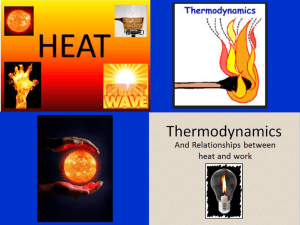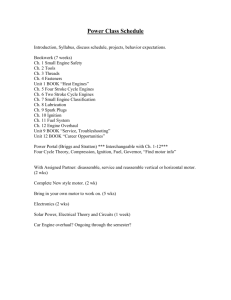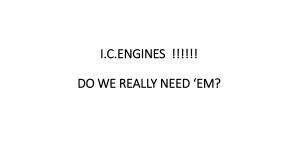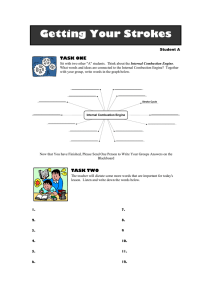The two main types of heat engines are the external engine.
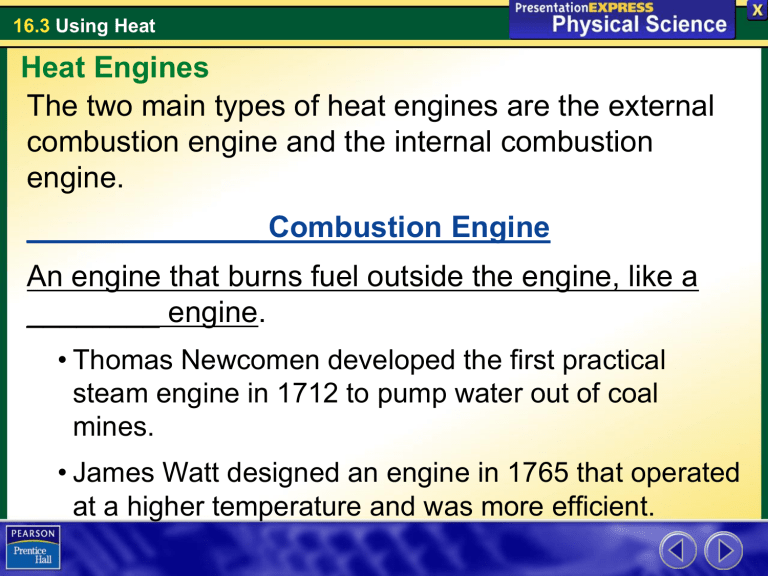
16.3 Using Heat
Heat Engines
The two main types of heat engines are the external combustion engine and the internal combustion engine.
______________ Combustion Engine
An engine that burns fuel outside the engine, like a
________ engine.
• Thomas Newcomen developed the first practical steam engine in 1712 to pump water out of coal mines.
• James Watt designed an engine in 1765 that operated at a higher temperature and was more efficient.
16.3 Using Heat
Heat Engines
When the valve in a steam engine slides, steam is trapped in the cylinder.
The steam expands and cools as it pushes the piston to the left.
Hot steam in
Slide valve
Exhaust steam out
Valve rod
Piston rod
Cylinder Piston
16.3 Using Heat
Heat Engines
_______________Combustion Engine
A heat engine in which the fuel burns inside the engine.
Most internal combustion engines use pistons that move up and down inside cylinders.
Each upward or downward motion of a _________ is called a ____________.
16.3 Using Heat
Heat Engines
Most cars have a ______-stroke internal combustion engine. This diagram shows only one of the cylinders during each stroke. See page 487!
Intake valve
Spark plug
Exhaust valve
Cylinder
Piston
Air-fuel mixture
Exhaust gases
Intake stroke Compression Stroke Power stroke Exhaust stroke
16.3 Using Heat
Heating Systems
____________________Heaters:
• At the boiler, heating oil or natural gas burns and heats water.
• The circulating pump carries the hot water to radiators in each room.
• The hot water transfers thermal energy to the radiator by conduction.
• The hot pipes heat the room air by conduction and radiation.
• Hot air rises and sets up a convection current in each room.
• The cooled water returns to the boiler.
Radiator
Thermostat
Exhaust Expansion tank vent
Boiler
Circulating pump
16.3 Using Heat
Steam Heating
Steam heating is very similar to hot-water heating except that steam is used instead of ___________________.
Electric Baseboard Heating
An electric baseboard heater uses electrical energy to heat a room.
• The hot coil heats the air near it by ______________ and
_______________ .
• Convection circulates the warm air to heat the room.
16.3 Using Heat
______________ Heating
Use fans to circulate warm air through ducts
• __________ circulates air in each room.
Cool air sinks
• Warm air entering the room rises toward the ceiling.
• Cool room air returns to the furnace through floor vents on the other side of the room.
Return vent
Duct
Furnace
Hot air rises
Supply vent
Chimney
16.3 Using Heat
Cooling Systems
• A ____________ is a device that reverses the normal flow of thermal energy.
• A_________is a fluid that vaporizes and condenses inside the tubing of a heat pump.
____________________
A heat pump that transfers thermal energy from the cold food compartment to the warm room.
16.3 Using Heat
Cooling Systems
When a refrigerator door is open, some thermal energy from the room enters the refrigerator. More thermal energy leaves the refrigerator through the coils.
Temperature in room: 25 °C
Temperature in refrigerator: 3 °C

